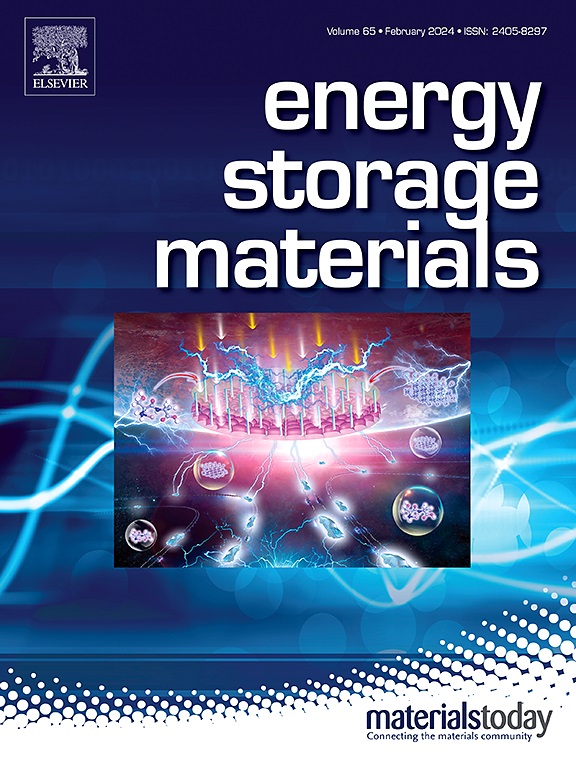Excess-lithium-free LLZO enabling fast ion conduction and ultra-low interfacial resistance for solid-state lithium metal batteries
IF 20.2
1区 材料科学
Q1 CHEMISTRY, PHYSICAL
引用次数: 0
Abstract
Garnet-type La6.25Ga0.25La3ZrO12 (LLZO:Ga) is a leading solid electrolyte for next-generation solid-state lithium batteries (SSLBs), yet its widespread adoption is hindered by the routine need for excess lithium and protective powder coverings during synthesis, both of which increase costs and compromise interface stability. Here, we present a scalable, excess-lithium-free synthesis of LLZO:Ga that achieves ultrafast Li-ion conductivity of 1.64(3) × 10–3 S/cm at 25 °C, surpassing many Li-rich counterparts. Molecular dynamics simulations reveal that excess lithium blocks diffusion pathways, hindering ion mobility and cooperative hopping. Remarkably, the zero-Li-excess LLZO:Ga delivers ultralow interfacial resistance (∼5 Ω·cm2) in symmetric Li|LLZO:Ga|Li cells, enabling stable cycling beyond 700 h at 0.2 mA/cm2 with minimal overpotential (∼60 mV). Full cells paired with LiFePO4 retain ∼96 % capacity over 80 cycles (at 0.1C), demonstrating practical viability. This work establishes a new benchmark in solid electrolyte design, achieving high conductivity, stable interfaces, and scalable processability without lithium excess.


过量无锂LLZO实现固态锂金属电池的快速离子传导和超低界面电阻
石榴石型La6.25Ga0.25La3ZrO12 (LLZO:Ga)是下一代固态锂电池(sslb)的主要固体电解质,但其广泛采用受到合成过程中常规需要过量锂和保护粉末覆盖的阻碍,这两者都增加了成本并损害了界面稳定性。在这里,我们提出了一种可扩展的,过量无锂的LLZO:Ga合成方法,在25 °C下实现了1.64(3) × 10-3 S/cm的超快锂离子电导率,超过了许多富含锂的同行。分子动力学模拟表明,过量的锂阻断了扩散途径,阻碍了离子迁移和协同跳跃。值得注意的是,零锂过量LLZO:Ga在对称Li|LLZO:Ga|锂电池中提供了超低的界面电阻(~ 5 Ω·cm2),能够以0.2 mA/ cm2的速度稳定循环700小时以上,并具有最小的过电位(~ 60 mV)。与LiFePO4配对的完整电池在80次循环(0.1C)中保持96%的容量,证明了实际的可行性。这项工作建立了固体电解质设计的新基准,实现了高导电性,稳定的界面和可扩展的可加工性,而没有锂过量。
本文章由计算机程序翻译,如有差异,请以英文原文为准。
求助全文
约1分钟内获得全文
求助全文
来源期刊

Energy Storage Materials
Materials Science-General Materials Science
CiteScore
33.00
自引率
5.90%
发文量
652
审稿时长
27 days
期刊介绍:
Energy Storage Materials is a global interdisciplinary journal dedicated to sharing scientific and technological advancements in materials and devices for advanced energy storage and related energy conversion, such as in metal-O2 batteries. The journal features comprehensive research articles, including full papers and short communications, as well as authoritative feature articles and reviews by leading experts in the field.
Energy Storage Materials covers a wide range of topics, including the synthesis, fabrication, structure, properties, performance, and technological applications of energy storage materials. Additionally, the journal explores strategies, policies, and developments in the field of energy storage materials and devices for sustainable energy.
Published papers are selected based on their scientific and technological significance, their ability to provide valuable new knowledge, and their relevance to the international research community.
 求助内容:
求助内容: 应助结果提醒方式:
应助结果提醒方式:


